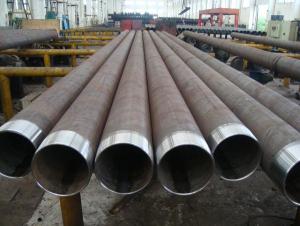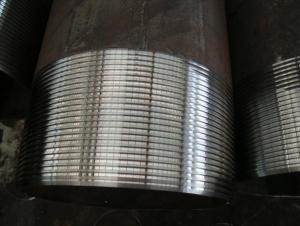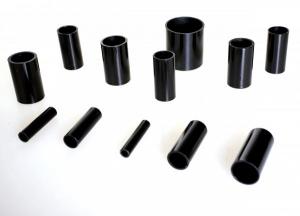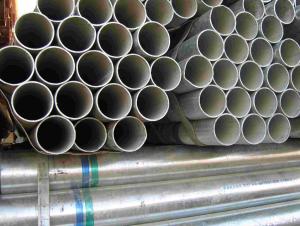Oil Tubing / Petroleum Pipe
- Loading Port:
- Baoshan Port
- Payment Terms:
- TT or LC
- Min Order Qty:
- 50MT m.t.
- Supply Capability:
- 5000 Tons Per Month m.t./month
OKorder Service Pledge
OKorder Financial Service
You Might Also Like
1. Outside Diameter of Oil Tubing / Petroleum Pipe
For upset pipe, the following tolerances apply to the outside diameter of the pipe body immediately behind the upset for a distance of approximately 127 mm (5.0 in) for sizes Label 1: 5-1/2 and smaller, and a distance approximately equal to the outside diameter for sizes larger than Label 1: 5-1/2. Measurements shall be made with callipers or snap gauges.
|
Label 1 |
Tolerances behind meuor L0 |
|
£3-1/2 |
+ 2.38 mm to – 0.79 mm (+ 3/32 in to – 1/32 in) |
|
|
|
|
>3-1/2 to £5 |
+ 2.78 mm to – 0.75% D(+ 7/64 in to – 0.75% D) |
|
|
|
|
>5 to £8-5/8 |
+ 3,18 mm to – 0,75% D(+ 1/8 in to –0.75% D) |
|
|
|
|
>8-5/8 |
+ 3,97 mm to – 0,75% D(+ 5/32 in to – 0.75% D) |
|
|
|
For Label 1: 2-3/8 and larger external-upset tubing the following tolerances shall apply to the outside diameter at distance La(see Figure D.5) from the end of the pipe.
The measurements shall be made with snap gauges or calli pers. Changes in diameter between Laand Lbshall be smooth and gradual. Pipe body OD tolerances do not apply for a distance of Lbfrom the end of the pipe.
|
|
Label 1 |
Tolerances |
|
|
|
|
|
|
³2-3/8 to £3-1/2 |
+ 2,38 mm to – 0,79 mm (+ 3/32 in to – 1/32 in) |
|
|
|
|
|
|
>3-1/2 to £4 |
+ 2,78 mm to – 0,79 mm (+ 7/64 in to – 1/32 in) |
|
|
|
|
|
|
>4 |
+ 2,78 mm to – 0,75% D(+ 7/64 in to – 0.75% D) |
|
|
|
|
|
2. Wall thickness of Oil Tubing / Petroleum Pipe |
| |
|
Tolerance – 12,5% |
| |
|
3. Mass of Oil Tubing / Petroleum Pipe |
| |
|
Amount |
Tolerance | |
|
Single lengths |
+ 6.5% to – 3.5% | |
|
Carload 18 144 kg (40 000 lb) or more |
– 1.75% | |
|
Carload less than 18 144 kg (40 000 lb) |
– 3.5% | |
|
Order items 18 144 kg (40 000 lb) or more |
– 1.75% | |
|
Order items less than 18 144 kg (40 000 lb) |
– 3.5% | |
Details picturers of Oil Tubing / Petroleum Pipe shown as below,
Package:By Strip.Black painting ,plastic caps,marks on pipe body.
We are also a manufacturer,so we can provide the products in conformity with your requirements rapidly.
Our products is accord with the standard of API 5L, API 5CT of American Petroleum Institute,the standard of ASTM A252,ASTM A53 and ASTM A500 of American Society Testing and Materials and standard of EN10217 and EN10219 of the European Union and passed the certification of ISO90012008 International quality management system.
Production line,imported equipment with high technology to low down cost,so we offer low price with good quality.
Our company has rich technical force and advanced production equipment and coordinated advanced test equipment and method.

Advanced production line.Ensure good quality.
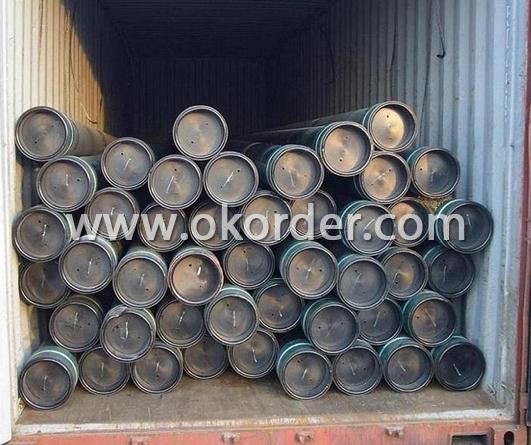
Container loading,professional and experienced service team for clients to ensure no damage.
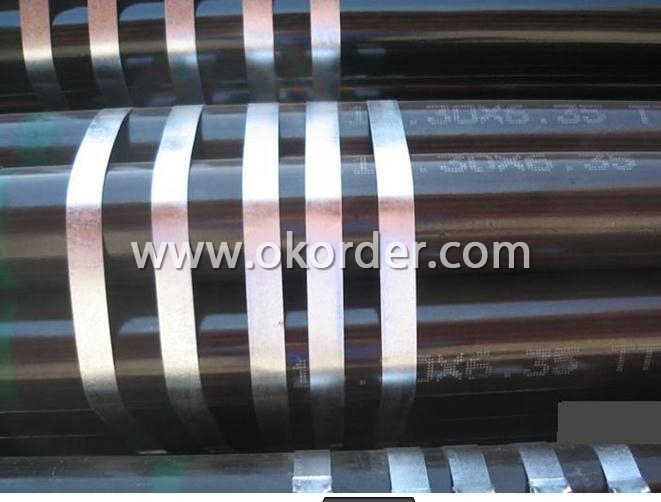
With steel strip to make sure good condition.
Welcome to order from us for Oil Tubing / Petroleum Pipe.
We will be happy to give you a excellent quotation according to your detailed requirements.
- Q:What are the factors to consider when selecting steel pipes?
- Some factors to consider when selecting steel pipes include the intended application and environment, the required strength and durability, the size and thickness of the pipes, the corrosion resistance, the cost, and the availability of different types of steel pipes.
- Q:What is the weight of steel pipes?
- The weight of steel pipes can vary depending on their size, length, and thickness. However, on average, steel pipes typically weigh between 1.1 to 1.5 pounds per foot.
- Q:What are the advantages of PVC pipe and galvanized steel pipe?
- PVC pipeline use temperature is -5 to 90 degrees or so, according to the current market price of around 6000 yuan per ton, the price is cheap. Its corrosion resistance is good, can resist most of the acid and alkali, and unlike the steel pipe that is easy to rust, so in the construction of the upper and lower water pipes and other fields have gradually replaced the trend of steel pipe.
- Q:Can steel pipes be used for mining applications?
- Yes, steel pipes can be used for mining applications. Steel pipes are commonly used in the mining industry for various purposes. They are often used for transporting fluids, such as water or slurry, in mining operations. Steel pipes are known for their durability, strength, and resistance to corrosion, making them suitable for underground mining environments where conditions can be harsh and corrosive. They can withstand high pressure and are able to handle the heavy loads associated with mining applications. Additionally, steel pipes can be easily welded and connected, allowing for efficient installation and maintenance. Overall, steel pipes are a reliable and cost-effective choice for mining applications.
- Q:How much is 4 inches steel tube MM?
- The standard wall thickness is 4mm, so the outer diameter is 114mm.
- Q:What are the different methods of pipe joining for steel pipes?
- Steel pipes can be joined using various methods, each with its own benefits and drawbacks. These methods include: 1. Butt Welding: Two steel pipes are welded together by beveling or facing their ends to form a V-groove. Molten metal is then used to fill the groove, creating a strong and long-lasting joint. 2. Socket Welding: A socket is welded onto the end of a steel pipe, and another pipe is inserted into the socket and welded in place. This method creates a leak-proof and corrosion-resistant joint. 3. Threaded Joint: Steel pipes can be joined by threading the ends and using a threaded coupling or union to connect them. This method is commonly used for smaller pipes and allows for easy disassembly and reassembly. 4. Flanged Joint: For larger pipes, a flange is attached to the end of each pipe, and the flanges are fastened together with gaskets using bolts. This method is commonly used in industries such as oil and gas, water treatment, and chemical processing. 5. Grooved Joint: Grooving machines are used to create a groove on the outside of the pipe. A coupling or fitting is then inserted into the groove and secured with bolts or clamps. This method is quick to install and allows for easy disassembly and reassembly. The choice of pipe joining method depends on factors such as pipe size, application, and desired strength and durability. Each method has its own advantages and disadvantages.
- Q:What are the different types of steel pipe coatings?
- There are several types of steel pipe coatings, including epoxy coatings, polyethylene coatings, polyurethane coatings, and zinc coatings.
- Q:What are the different types of coatings used for steel pipes?
- There are several types of coatings commonly used for steel pipes, including epoxy coatings, polyethylene coatings, zinc coatings, and coal tar coatings. Each type of coating offers unique benefits and is used for specific applications to protect the steel pipes from corrosion and other forms of damage.
- Q:What is the maximum diameter of steel pipes?
- The maximum diameter of steel pipes can vary depending on various factors such as manufacturing capabilities, industry standards, and specific project requirements. However, steel pipes can typically range from a few millimeters in diameter for small-scale applications to several meters in diameter for large-scale industrial projects.
- Q:What are the factors to consider when selecting a steel pipe for a specific application?
- When selecting a steel pipe for a specific application, there are several factors that need to be considered. These factors include the required strength and durability, the intended use and environment, the size and dimensions needed, the corrosion resistance properties required, the temperature and pressure conditions, and the budget available for the project. By taking all these factors into account, one can choose the most suitable steel pipe that meets the specific requirements of the application.
1. Manufacturer Overview |
|
|---|---|
| Location | Shanghai China |
| Year Established | 1999 |
| Annual Output Value | Above Thirty Million RMB |
| Main Markets | Main land;Middle East; Southeast Asia |
| Company Certifications | ISO 9001:2010;API 5L |
2. Manufacturer Certificates |
|
|---|---|
| a) Certification Name | |
| Range | |
| Reference | |
| Validity Period | |
3. Manufacturer Capability |
|
|---|---|
| a)Trade Capacity | |
| Nearest Port | Baoshan |
| Export Percentage | 41% - 50% |
| No.of Employees in Trade Department | 300-500 People |
| Language Spoken: | English; Chinese |
| b)Factory Information | |
| Factory Size: | 30,000 square meters |
| No. of Production Lines | Above 10 |
| Contract Manufacturing | OEM Service Offered; Design Service Offered |
| Product Price Range | Average |
Send your message to us
Oil Tubing / Petroleum Pipe
- Loading Port:
- Baoshan Port
- Payment Terms:
- TT or LC
- Min Order Qty:
- 50MT m.t.
- Supply Capability:
- 5000 Tons Per Month m.t./month
OKorder Service Pledge
OKorder Financial Service
Similar products
New products
Hot products
Hot Searches
Related keywords
